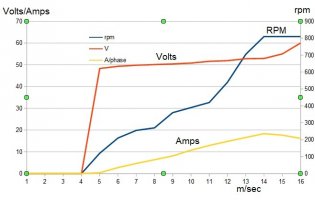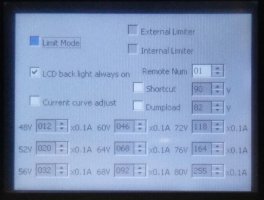For a wind turbine the characteristics of it are something like this with the way that the voltage increases as the current increases up until the frequency and high current then start to dissipate energy in the form of hysterisis losses in the wind turbine core, which is why the current then starts to drop.

The rpm would continue to rise if not restrained and destroy the turbine, which needs a way to either turn the turbine out of the wind, alter the pitch of the blades or for the blades to "stall" like an aeroplane and they then lose lift and lose energy to turn the turbine around. Braking the turbine effectively stalls the blades and reduces the captured energy, while turning out of the wind is the most simple option.

Ignoring the rpm (only interested in volts at this point) simple PWM type wind controllers that try to hold a fixed voltage level and will stall the wind turbine in low wind speeds (lots of people complaining on the internet about low output but do not realise why...) and therefore the wind turbine will never return much energy until it is blowing a lot and then it will over speed and either burn out or destroy itself (another set of complaints).
What a good controller should do is PWM regulate as a function of the turbine rpm or MPPT track the profile for the specific wind turbine (not all turbines have the same characteristics, unlike solar. The other option is what some other controllers do is allow set voltage levels and power output to be defined, which can then be set and matched to a turbine.
The alternative DIY approach is to use a number of boost converters and set each boost converter to a higher starting voltage level and the output current to a given level.
In the diagram I show the first startup boost converter would have an input voltage minimum of around 48.5V and an output current of say 5 Amps. What would happen is that as the turbine starts up it would reach 48.5V and then start delivering power and the voltage would be held at 48.5V until more than 5A was output and then it would rise up.
The next boost controller would have a minimum input voltage of 50V and an output current of around 5A.
The next boost controller would have a minimum input of 52V and an output current of around 5A.
The last boost controller would have a minimum input of 54V and an output current of 20A (brake, fail safe)
An additional boost could be added as a backup.
This way a few $15 boost controllers could do a far better job than a cheap PWM unit and allow them to be tuned / aldtered for any turbine.
For grid tie have a look at the settings for these units where they allow the current levels to be changed (hepefully the voltage as well)
https://www.aliexpress.com/item/100...ler-Resistor-for-3-Phase-24v/32771267646.html

This unit seems to have no fan and an "integrated" dump load
https://www.aliexpress.com/item/48V...ybrid-charge-controller-500w/32813929689.html
I wonder what would happen if this unit needed to dump 500W for an hour and was attached to a bit of wood....
No indication if it actually tracks the rpm, volts, amps or just tries to stall the trubine delivering the maximum amps at the charge voltage.
So many of these type seem to be advertised so poorly, no wonder there are many people complaining about poor wind turbine output..... square peg, round hole.
With reference to my charts, notice that this item has a brake voltage option of 56V, note this is the 3 phase AC voltage....
https://www.aliexpress.com/item/Bra...wind-turbine-grid-tie-system/32298858960.html







